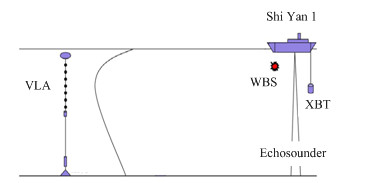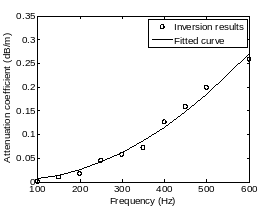Bottom acoustic parameters greatly influence the acoustic propagation in the ocean, such as sediment sound speed, density, and attenuation. The bottom acoustic parameters can be obtained by direct measurement. However, direct measurement in deep water is much harder than that in shallow water. Therefore, it is significant to invert the bottom acoustic parameters in a large-scale area of deep water.
Geoacoustic inversion is an important issue in underwater acoustics. With the development of underwater acoustics from shallow to deep water, geoacoustic inversion needs be researched into more depth in deep water. Recently, in the deep-water area of the South China Sea, the geoacoustic inversion method is used for bottom acoustic parameters by researchers from the Institute of Acoustics of the Chinese Academy of Sciences.
According to analysis, bottom acoustic parameters are more sensitive to the transmission-loss data in the shadow zone of deep water because of the reflection by the sea bottom. So the bottom parameters can be inverted by a geoacoustic inversion method comparing experimental transmission-loss data with the numerical transmission-loss. Moreover, the propagation track is about 250 km which contains five shadow zones. The long range transmission-loss data are used to invert bottom acoustic parameters.
The experimental equipment layout was shown in Fig.1. The nominal detonation depth of wide band signals was 200 m. A vertical receiver array was composed of 27 underwater signal recorders from depth of 100 m to 1800 m. It was nearly a flat bottom with the mean depth of 4305 m along the propagation tracks. And the sound speed profile was measured by CTD casted near the receiver array. The environment was an incomplete deep-water sound channel, in which sound waves could interact with the bottom many times for long range propagation. Therefore, the bottom acoustic parameters could be well estimated from this kind of acoustic signals.

Fig.1 Experimental configuration (Image by WU)
The transmission-loss data were used to invert bottom parameters, i.e., sound speed, density and attenuation coefficient. And the bottom was assumed to be a uniform liquid half-space sea bottom model. The Hamilton sediment empirical relationship between the sound speed and the density was used in the inversion to reduce the dimension of unknown parameters.
In the following, the sensitivity of transmission-loss data was analyzed to each seabed parameter. It was found that the transmission-loss data in the proper ranges should be chosen in inversion. Transmission-losses were more sensitive to the bottom sound speed than the attenuation coefficient in the first and second shadow zones.
The sound speed  was inverted from transmission-losses at the frequency of 300Hz in the range of 20-70 km. Also, the bottom density from the Hamilton sediment empirical relationship at the same time was obtained by choosing a reasonable bottom attenuation coefficient of 0.2
was inverted from transmission-losses at the frequency of 300Hz in the range of 20-70 km. Also, the bottom density from the Hamilton sediment empirical relationship at the same time was obtained by choosing a reasonable bottom attenuation coefficient of 0.2 . The inverted sound speed and density were 1558 m/s and 1.56 g/cm3, respectively.
. The inverted sound speed and density were 1558 m/s and 1.56 g/cm3, respectively.
After getting the sound speed and density of the bottom, the attenuation coefficients at different frequencies were inverted from transmission-losses within the range of 70-250 km that were more sensitive to the bottom attenuation coefficient. The inversion of the attenuation coefficients was nonlinear over the frequency band from 100-600 Hz, shown in Fig.2. The solid line in Fig. 2 was the fitted curve with the nonlinear relationship: dB/m .
dB/m .

Fig. 2 Inverted attenuation coefficient at different frequencies (Image by WU)
Meanwhile, it was compared that the experimental transmission-losses and the numerical results calculated by using the inverted bottom parameters for another different propagation track in the South China Sea. It showed a well agreement between the experimental transmission-losses and the numerical results.
Funding for this research came from the National Natural Science Foundation of China (Grant Nos. 11434012, 11404366, 41561144006 and 11174312).
Reference:
WU Shuanglin, LI Zhenglin and QIN Jixing. Geoacoustic inversion for bottom parameters in the deep-water area of the South China Sea. Chinese Physics Letters (Vol. 32, No. 12: 124301, 23 November 2015). DOI: 10.1088/0256-307X/32/12/124301
Contact:
WU Shuanglin
Institute of Acoustics, Chinese Academy of Sciences, 100190 Beijing, China
Email: wushuanglin13@mails.ucas.ac.cn


